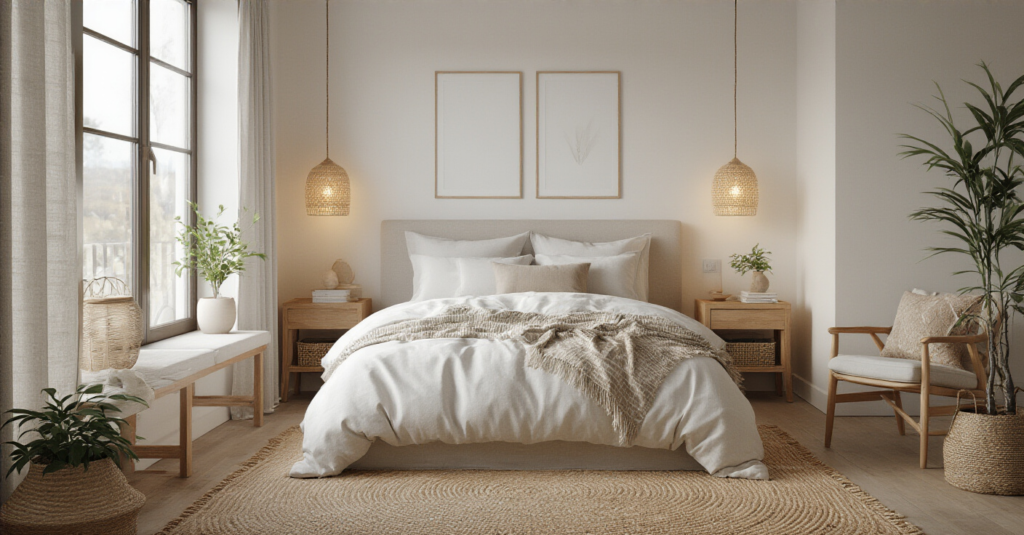You know what people always ask me when they buy a beautiful old house? It’s not about foundation cracks or rewiring costs, though that comes later. The first question, whispered almost like a confession, is always, “How do I make it feel cozy without ruining its character?” They see the good bones—the plaster walls, the wavy glass, the original hardwood floors—and they’re terrified that making it comfortable means erasing the very history they fell in love with.
And that’s the biggest misconception out there. Everyone thinks “cozy” comes from a big-box store in a plastic-wrapped set. They think it means ripping out the past to make way for generic, modern comfort. They’re wrong. True, lasting coziness doesn’t come from covering things up; it comes from leaning into the history of the space. It’s about working with the architectural story, not against it. It’s about choosing materials and lighting that feel as authentic and enduring as the house itself. Let’s talk about how to get it right.
Laying the Warm Foundation (Part 1)
Before you even think about buying a single pillow, we need to talk about the bones of the room. A cozy bedroom isn’t built on decoration; it’s built on a solid foundation of good layout, color, and light. Get these three things wrong, and you’ll be fighting an uphill battle, piling on blankets and trinkets to cover up a space that just feels… off. This is the architectural groundwork that makes everything else fall into place.
1. Assess Room Layout for Optimal Flow and Comfort
The biggest mistake I see homeowners make in historic bedrooms is fighting the original layout. They try to force a king-sized bed where a double was intended or ignore the fact that the fireplace was always meant to be the heart of the room. Stop. Before you move a single piece of furniture, stand in the doorway and just observe. Where does the light come from? What is the natural focal point? The room will often tell you how it wants to be arranged.
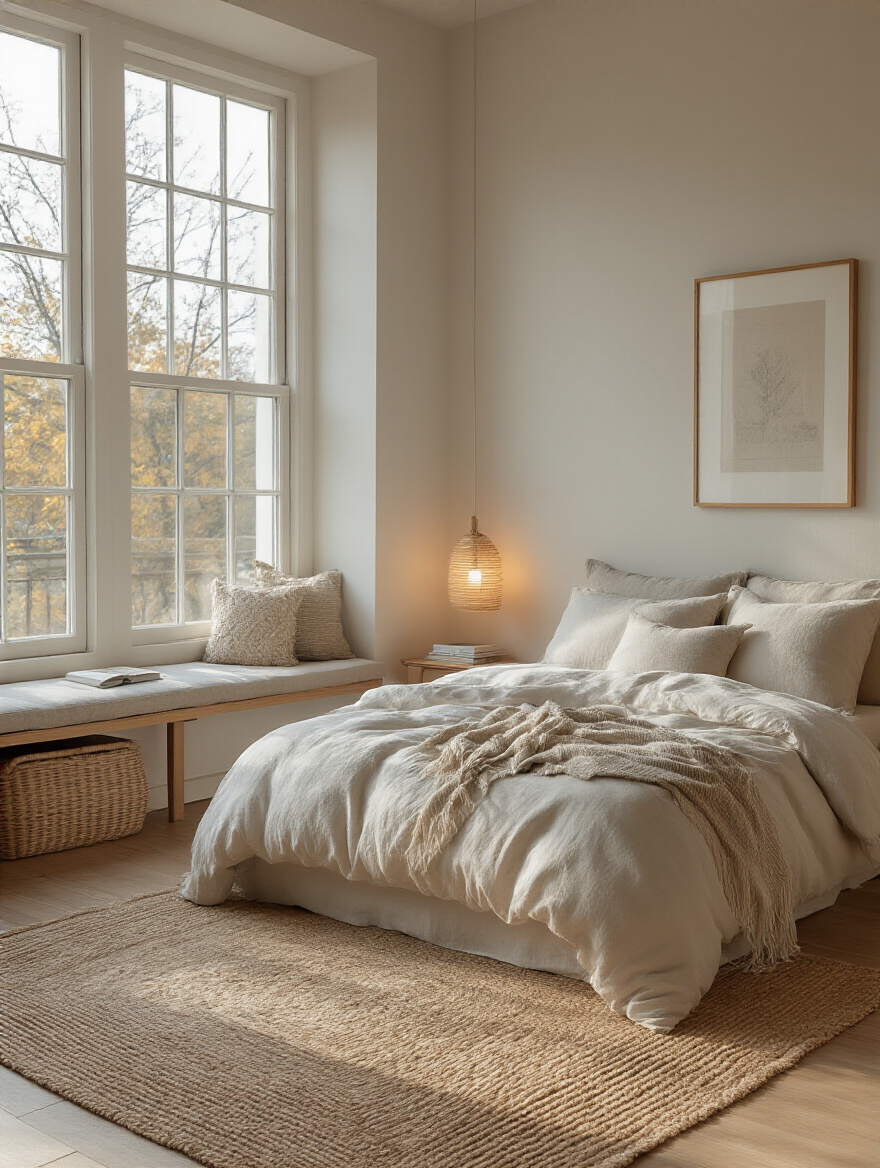
Your goal isn’t to cram in as much as possible, but to create clear, simple pathways. The path from the door to the bed and from the bed to the closet should be unimpeded. This creates a subconscious sense of calm, not constriction. In older homes with quirks like off-center windows or oddly placed doors, embrace them. Don’t try to hide them. Anchor your main furniture to the room’s strongest feature, and let the rest breathe. I once had a client with a small Victorian bedroom who insisted on pushing the bed against a wall, making the whole space feel cramped. We floated the bed just a foot off the center of the opposite wall, and the room instantly felt twice as large and a hundred times more serene.
Layout isn’t just about floor space; it’s the unspoken language of the room. Get it right, and you’re well on your way to creating a sanctuary. From here, we can begin to layer in the color that will bring it to life.
2. Select a Soothing Color Palette with Warm Undertones
Can we talk about the tyranny of sterile white paint? In a historic home, pure, cool-toned white can feel clinical and harsh, highlighting every imperfection and completely clashing with the home’s natural warmth. The secret to a cozy bedroom is a color palette rooted in warm undertones. Think of colors with a base of yellow, red, or brown—creams, beiges, muted terracotta, dusty roses, or deep mossy greens. These are the colors of nature, of earth and minerals, and they have an innate ability to make a room feel like an embrace.
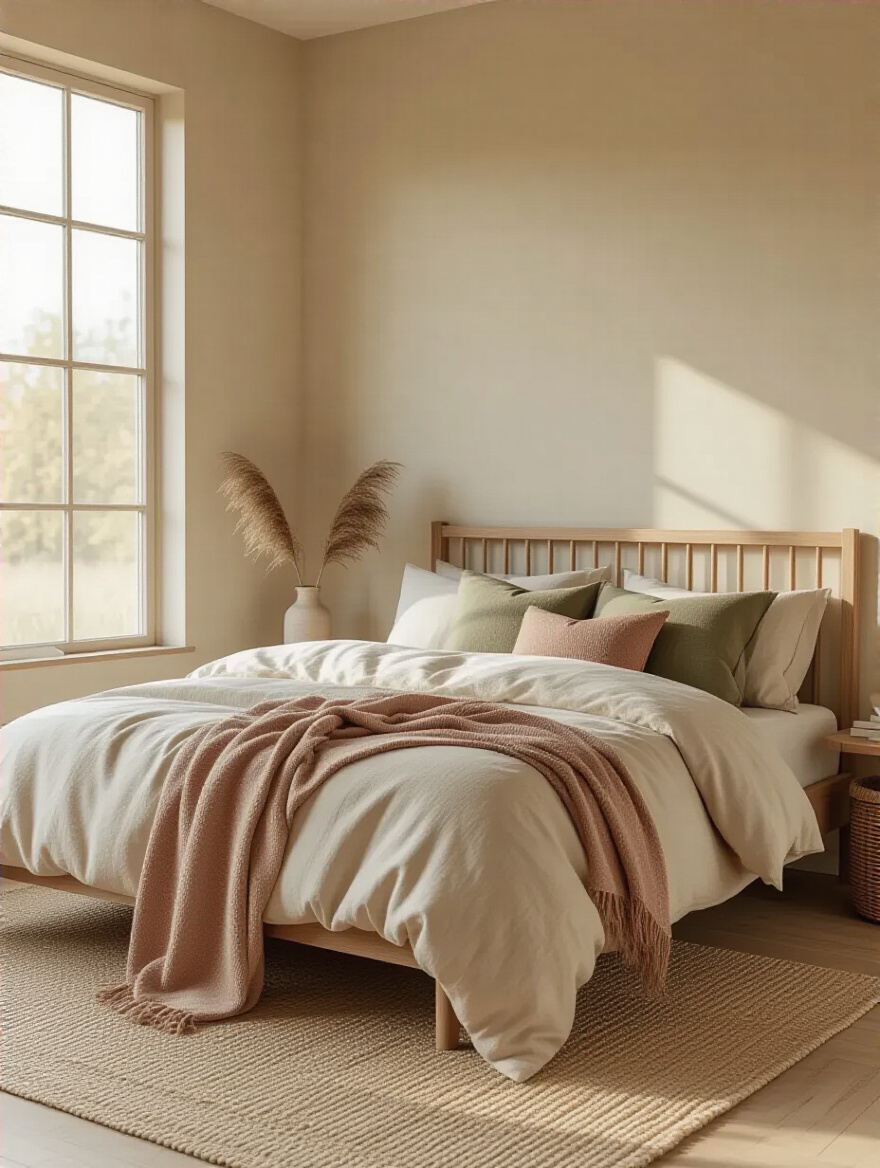
I always steer my clients toward historical paint collections from brands like Benjamin Moore or Farrow & Ball. These palettes are designed with the pigments and depths that would have been used originally, so they automatically feel harmonious with the architecture. When you pick your color, paint a large swatch on at least two different walls and watch it throughout the day. The way a warm “greige” catches the morning light versus how it glows in the evening lamplight is everything. Don’t just pick a color from a tiny chip under fluorescent store lighting. Live with it in the space first.
Color sets the emotional temperature of the room. Once you have that warm, soothing backdrop, the next step is to illuminate it in a way that enhances that feeling rather than fights it.
3. Plan Layered Lighting for Ambience and Function
If I could ban one thing from historic homes, it would be the single, flush-mounted “boob light” in the center of the ceiling. It’s a character-killing disaster. Historic rooms were never meant to be evenly flooded with harsh overhead light. They were lit in pockets—with candlelight, gas lamps, and early electric fixtures that created pools of warm, inviting glow. Your goal is to replicate that feeling with a modern, layered approach.
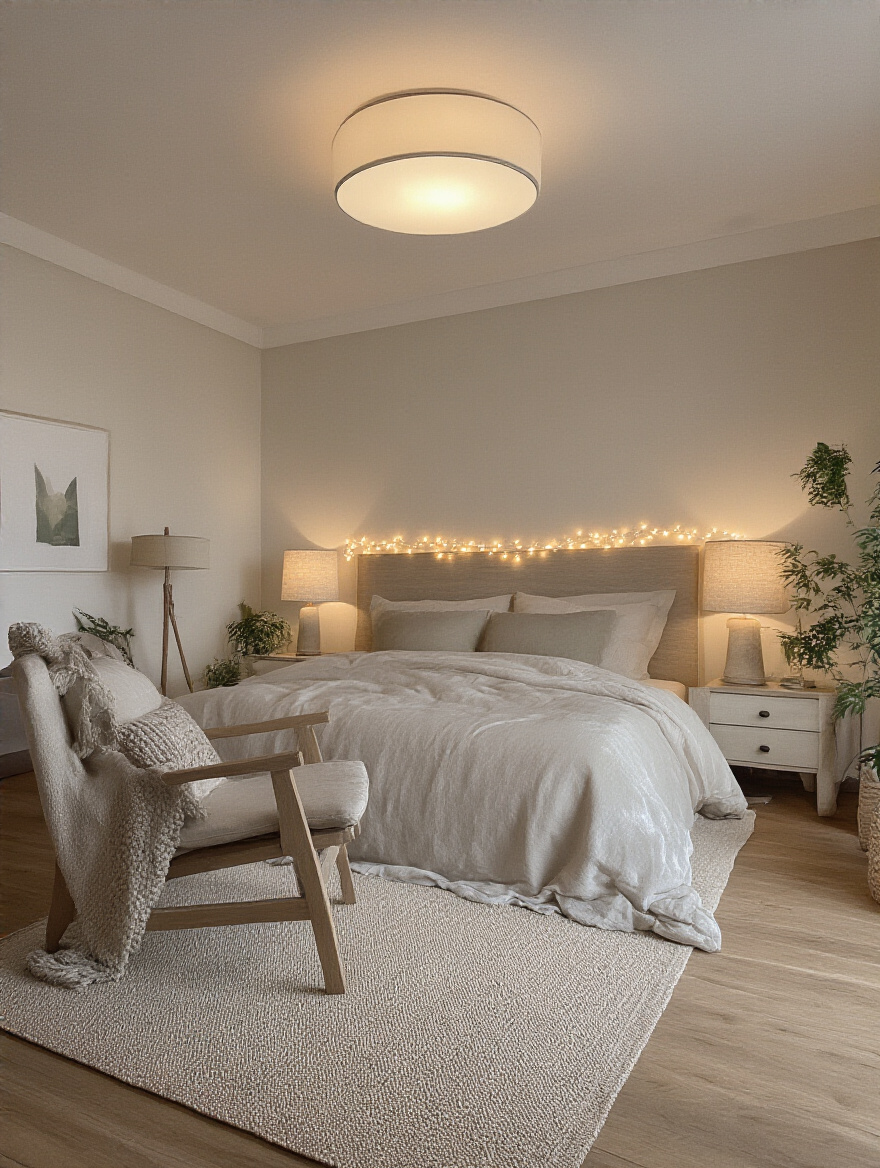
Layered lighting means having three types of light sources. First is Ambient: a general, soft overhead light, like a period-appropriate chandelier or a simple pendant, and it must be on a dimmer. This is your base layer. Second is Task: focused light for activities, like a reading lamp by a chair or sconces flanking the bed. This is functional. Third is Accent: soft, decorative light, like a small lamp on a dresser or uplighting a plant. This creates depth and mood. Having all three on separate controls gives you complete power over the room’s atmosphere.
When you can dim the main light to a faint glow and rely on the warm pools of light from your bedside lamps, the room is instantly transformed. It feels intimate, secure, and profoundly relaxing.
4. Prioritize Soft, Indirect Light Sources
This builds directly on the last point but is so critical it deserves its own space. The quality of your light is more important than the fixture itself. You want to avoid direct, harsh light shining down into your eyes at all costs. The goal is to create a soft, diffused glow that illuminates the room gently. Think of how sunlight filters through a linen curtain—that’s the effect we’re after.
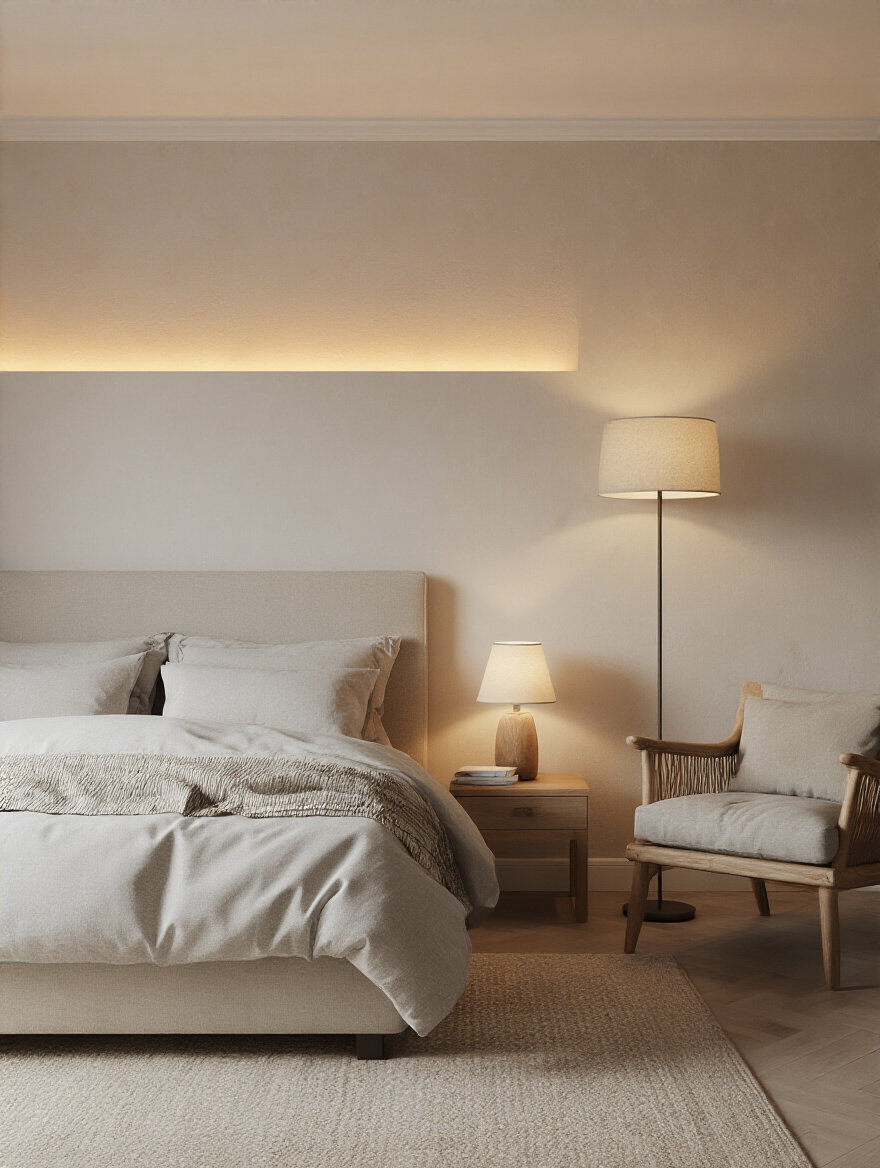
The easiest way to achieve this is with fabric lampshades that soften and warm the light passing through them. Another trick I love is using uplighters tucked behind a piece of furniture or a large plant to bounce light off the ceiling and back down into the room. This creates a beautiful, even illumination with no harsh glare. Wall sconces, especially those that direct light up and down the wall, are also fantastic. In a historic home with beautiful plaster walls, this technique highlights the texture and makes the room glow from within.
Laying the Warm Foundation (Part 2)
We’ve covered the invisible architecture of coziness—layout, color, and light. Now let’s move on to the tangible elements, the things you can touch and feel. This is where the sensory experience really begins to take shape, grounding the room in materials that are as honest and authentic as the house itself.
5. Incorporate Natural Materials for Texture and Warmth
Here’s the truth: synthetic materials feel dead. Polyester, plastic, laminate—they have no life, no soul. A truly cozy room, especially in an older home, sings with the texture and warmth of natural materials. This isn’t a trend; it’s a timeless principle. Wood, wool, linen, cotton, stone, and rattan connect us to the natural world and provide a tactile richness that cannot be faked.
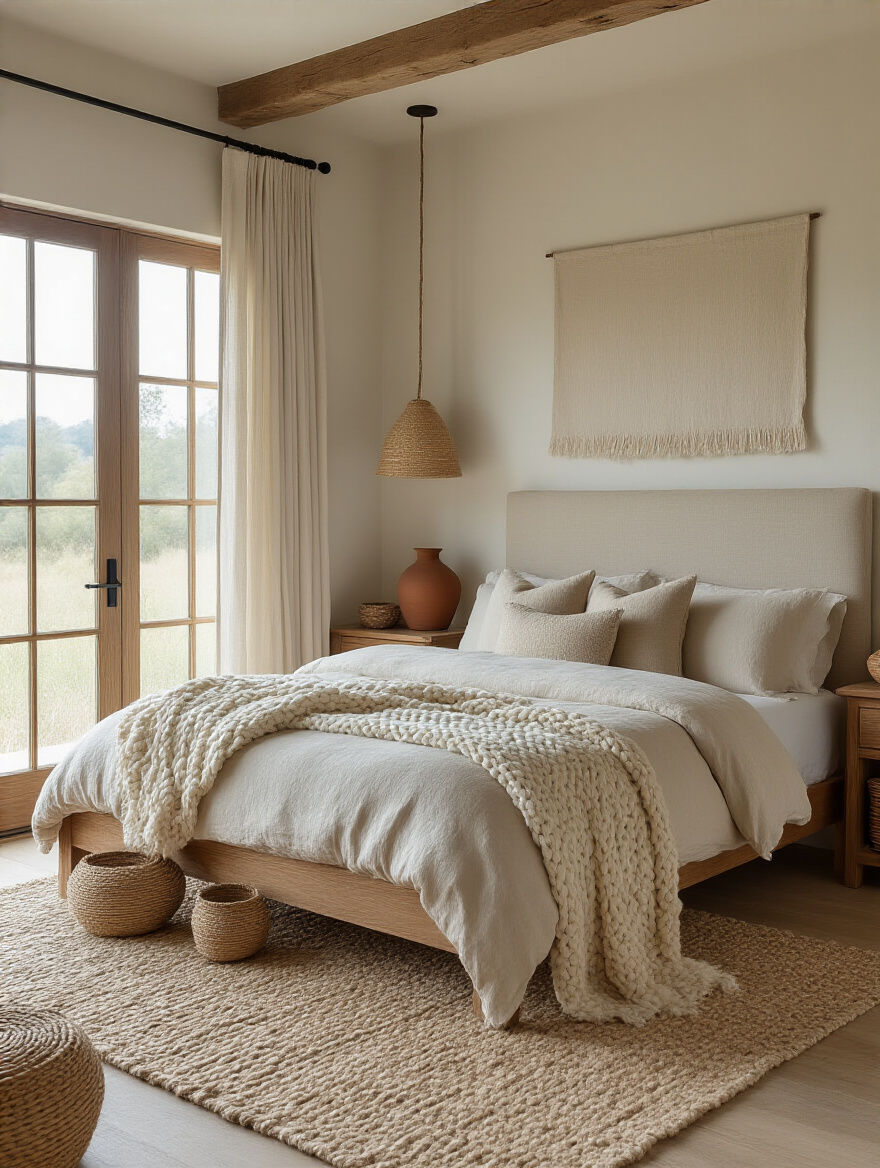
Look for opportunities to layer these materials everywhere. A solid wood bed frame, a wool area rug, crisp linen curtains, a chunky cotton knit throw, a single stone vase on the dresser. These elements have inherent warmth and patina. They age beautifully, unlike their plastic counterparts which just get old. Don’t be afraid to mix them. The smoothness of a worn wooden dresser next to the nubby texture of a jute basket creates a visual and tactile interest that is deeply satisfying. As William Morris said, “Have nothing in your house that you do not know to be useful, or believe to be beautiful.” Natural materials are almost always both.
Cultivating Core Comfort (Part 1)
Now we get to the heart of it all—the elements that scream “comfort” from the moment you walk in the door. These are the foundational soft textures and structural pieces that make a bedroom a true retreat, providing a sense of enclosure, softness, and security.
6. Choose Plush Bedding and Throws for Irresistible Softness
Your bed is the anchor of your bedroom, and the bedding is what makes it an irresistible haven. Don’t get caught up in the marketing nonsense of ultra-high thread counts. Focus on the feel of the material against your skin. For year-round comfort, nothing beats the soft, breathable quality of washed linen or long-staple cotton like percale or sateen. In colder months, brushed cotton or flannel is pure bliss.
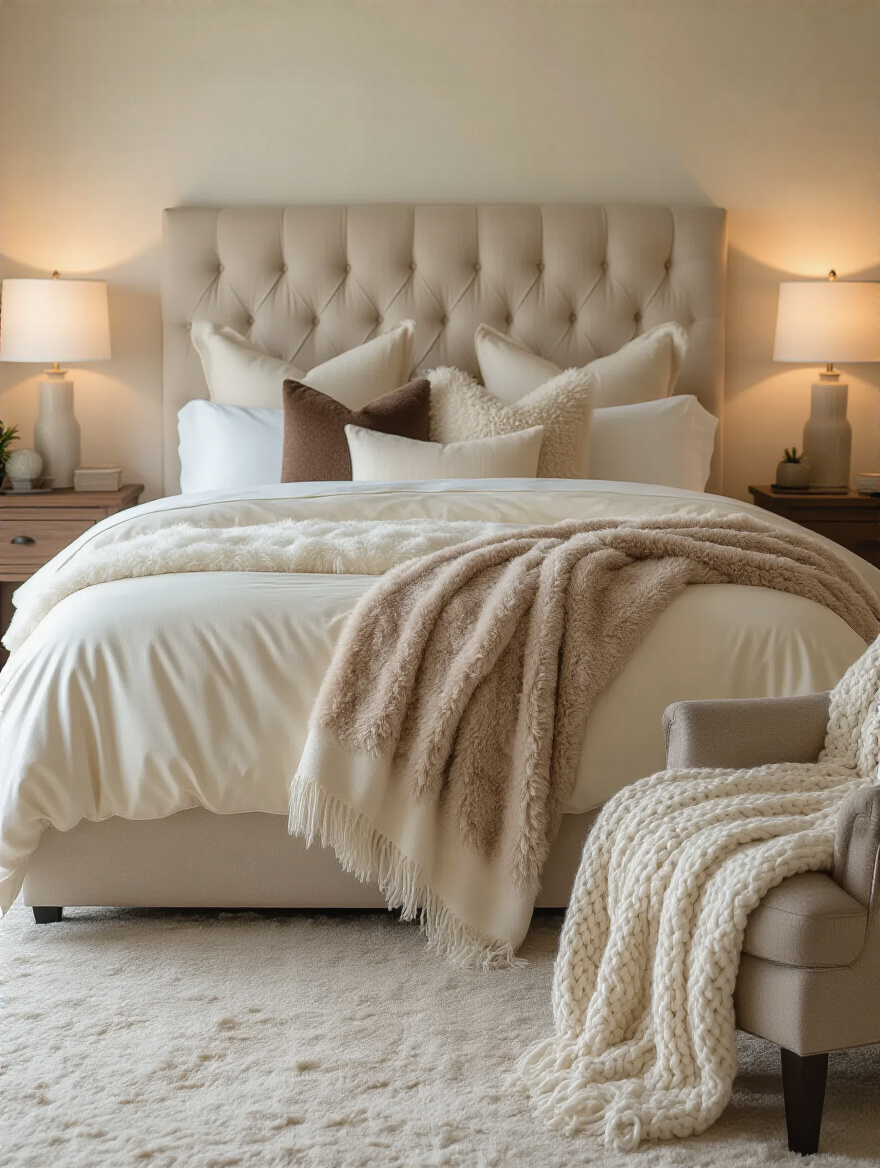
The real secret, however, is layering. Start with your essential sheets and duvet, then pile on the texture. A chunky knit wool throw draped at the foot of the bed, a velvet lumbar pillow, or even a faux fur blanket adds immediate visual warmth and tactile invitation. It makes the bed look and feel plush and decadent. I had a client whose bedroom felt a bit cold and sterile, despite good colors. We simply added a thick, cream-colored cable-knit throw and two velvet pillows. That one change transformed the entire mood of the room.
7. Opt for a Headboard that Adds Comfort and Visual Anchor
A bed without a headboard always looks unfinished, like it’s temporarily floating in the room. A headboard provides a crucial visual anchor, declaring “this is the place of rest.” But more importantly, it provides physical comfort. There’s nothing cozy about leaning against a cold, hard wall to read at night.
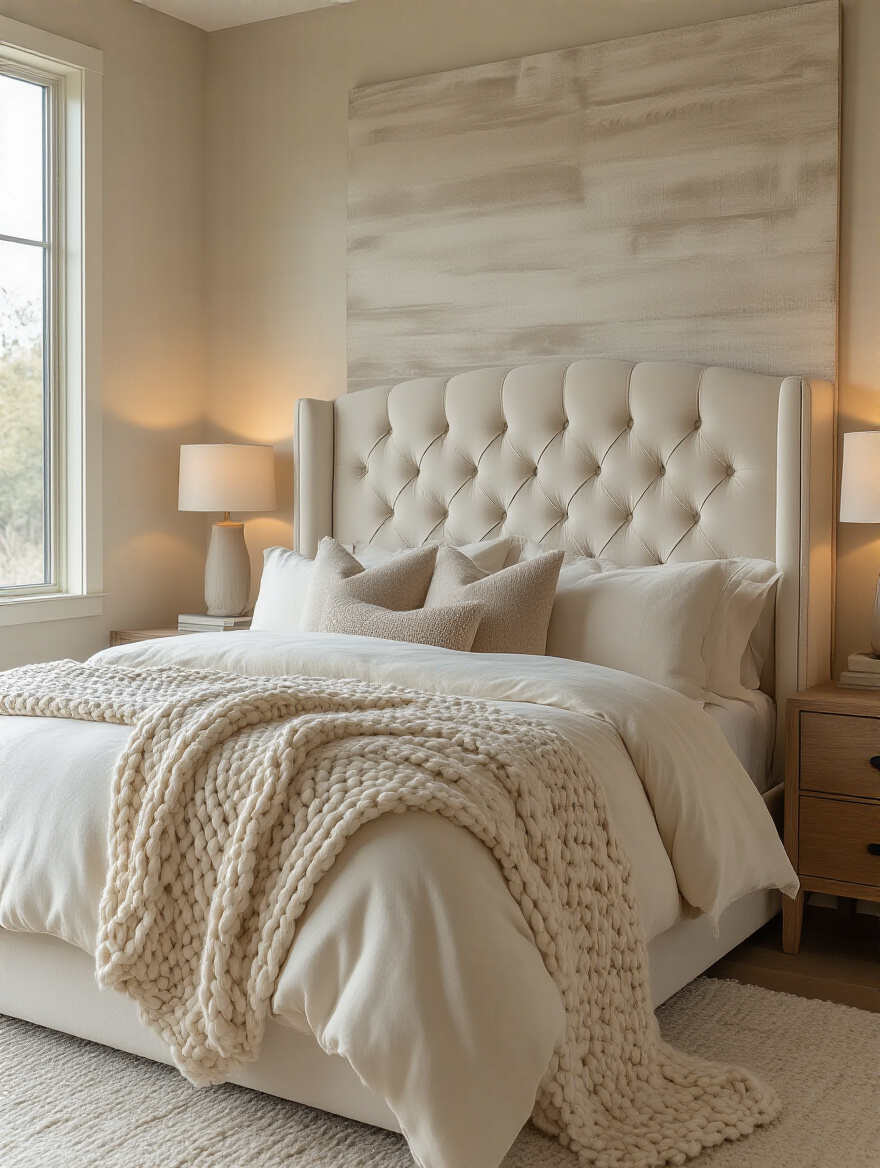
For maximum comfort, you can’t beat an upholstered headboard. A simple padded design in a durable, textured fabric like linen, boucle, or velvet adds a soft surface to lean against and introduces another layer of sound-dampening texture to the room. If upholstery isn’t your style, a solid wood headboard can provide rustic warmth, or a woven rattan one can add a touch of relaxed, bohemian character. Just make sure it feels substantial and grounds the bed, making it feel like a secure and protected space.
8. Integrate Cozy Area Rugs to Define Zones and Cushion Steps
Many historic homes have stunning hardwood floors, but leaving them completely bare in a bedroom can feel cold and stark, and sound can echo terribly. An area rug is essential. Its primary job is to provide a soft, warm place for your feet to land on a chilly morning—a small but profound daily luxury.
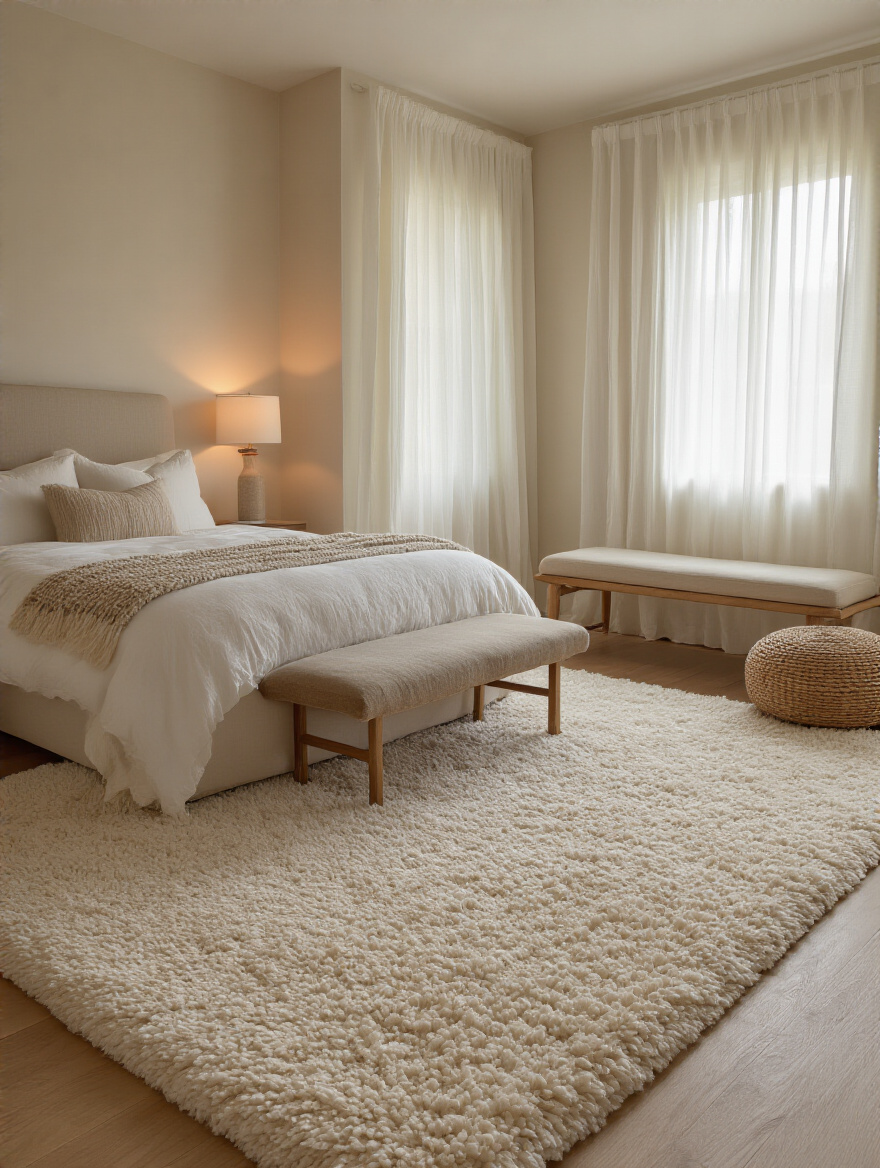
Proper sizing is critical here. For under the bed, the rug should extend at least 18-24 inches on either side and at the foot, anchoring the bed and its nightstands. The biggest mistake is getting a rug that’s too small; it ends up looking like a forgotten bath mat. Choose a rug made from a natural, comfortable material like wool. It’s durable, naturally stain-resistant, and feels incredible underfoot. A high-pile or shag rug offers the ultimate in plushness, while also being a fantastic sound absorber, muffling footsteps and dampening echo.
9. Select Substantial Window Treatments for Privacy and Insulation
Thin, flimsy blinds have no place in a cozy bedroom. In a historic home, substantial window treatments are not just for decoration; they are a functional necessity. Older windows can be drafty, and good treatments provide a critical layer of insulation, keeping the room warmer in winter and cooler in summer. This is one of those upgrades that pays for itself in both comfort and energy bills.
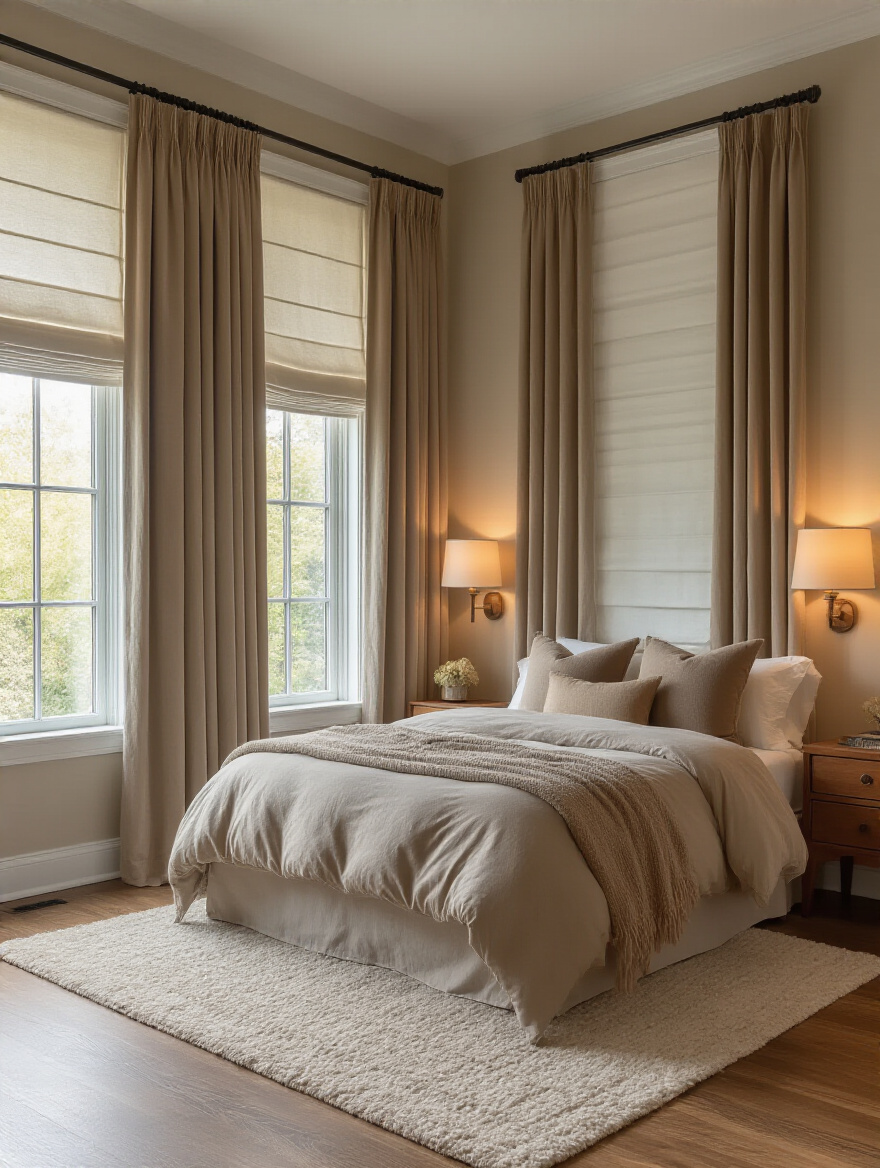
For the ultimate cozy effect, go with heavy, lined drapes. Fabrics like velvet, wool, or a thick linen blend have enough weight to hang beautifully while blocking light, muffling sound, and stopping drafts. To maximize their effectiveness, hang the curtain rod several inches above and beyond the window frame. This makes the window appear larger and ensures the drapes fully cover the edges, sealing out light and air. Layering them over a simple roman shade or cellular shade gives you even more control over light and privacy.
Cultivating Core Comfort (Part 2)
With the primary soft surfaces in place, we now turn to the furniture arrangement and supporting elements that refine the room’s function and atmosphere. These details are about creating intentional spaces for rest and quiet, and ensuring that every object serves the goal of tranquility.
10. Position Thoughtfully Curated Furniture for Intimacy
A cozy bedroom isn’t just a bed in a box. It’s a multi-functional space for unwinding. If you have the room, creating a small, secondary zone for quiet activity makes the entire space feel more like a luxurious suite. This doesn’t require a massive room. It can be as simple as placing a single, comfortable armchair in a corner with a small side table and a good lamp.
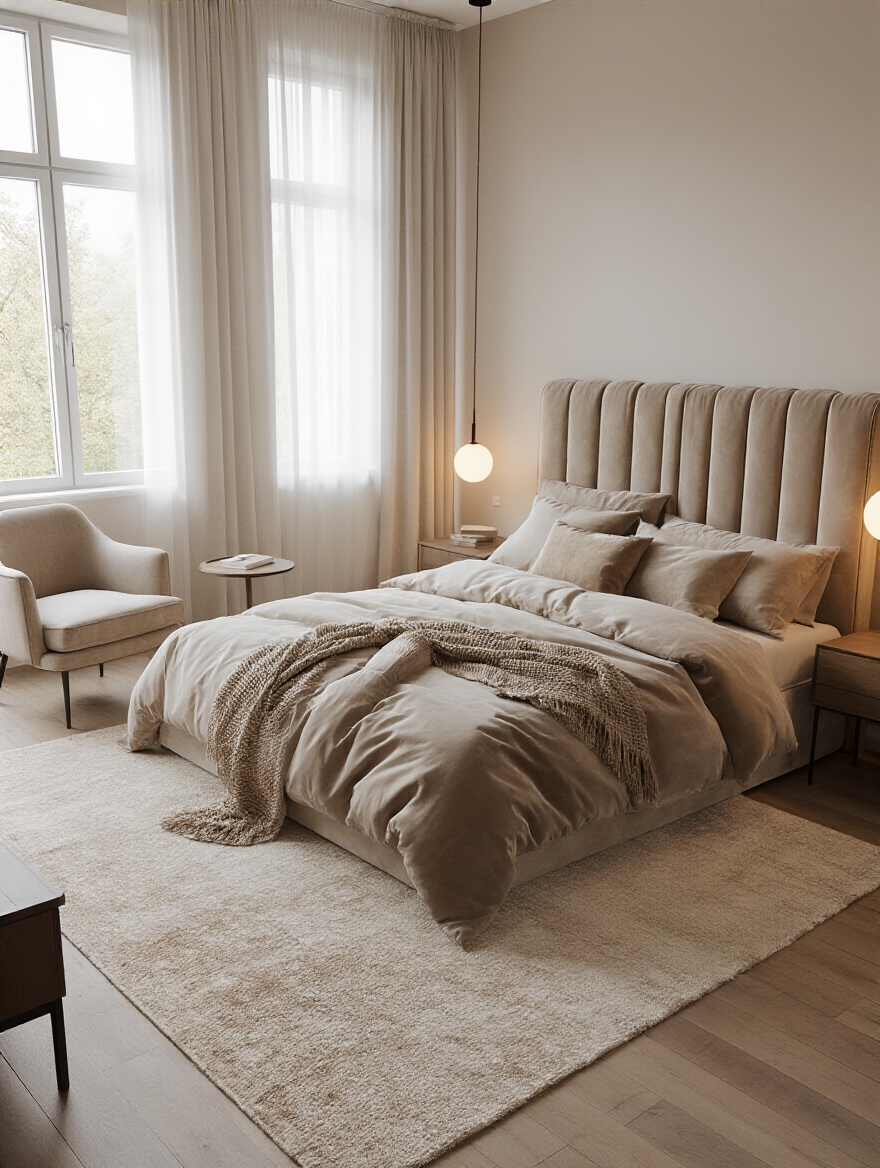
This creates a destination within the room that isn’t the bed—a place to read, sip tea, or just sit quietly. It breaks up the space and adds a layer of intentionality. Avoid the temptation to fill every corner. Negative space is important; it gives your eyes a place to rest. A few well-chosen, quality pieces with character—an antique dresser, a small writing desk—will always serve you better than a matching set of soulless, oversized furniture.
11. Introduce Strategic Task Lighting for Evening Rituals
We’ve already covered the importance of layered lighting, but it’s worth focusing specifically on task lighting for your evening wind-down. Having a dedicated light source for reading in bed or in your cozy armchair is non-negotiable. It allows you to turn off the brighter overhead lights and transition into a more relaxed state, signaling to your brain that it’s time for sleep.
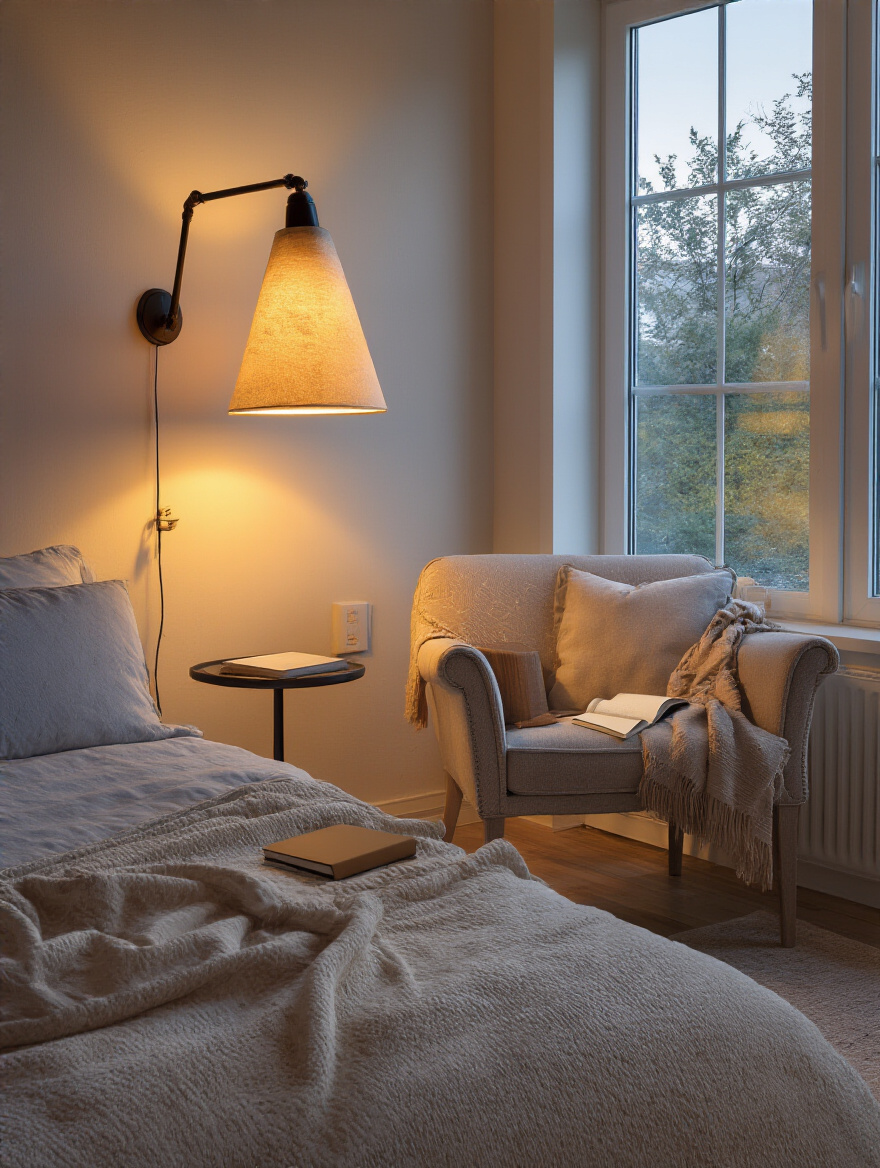
A wall-mounted swing-arm lamp is a fantastic option for bedside reading, as it frees up space on your nightstand. Make sure whatever you choose has a warm-toned bulb (look for something around 2700K on the packaging) and is directed onto your book, not into your eyes. This focused, gentle light prevents eye strain and helps maintain a sleepy, serene atmosphere for both you and your partner.
12. Utilize Soft Storage Solutions to Reduce Visual Clutter
Nothing kills a cozy vibe faster than clutter. Piles of clothes, stacks of books, and tangled chargers create visual noise that leads to mental stress. While good closets are key, sometimes you need accessible storage within the room. This is where soft storage shines. Instead of hard plastic bins, opt for solutions that add to the room’s texture and warmth.
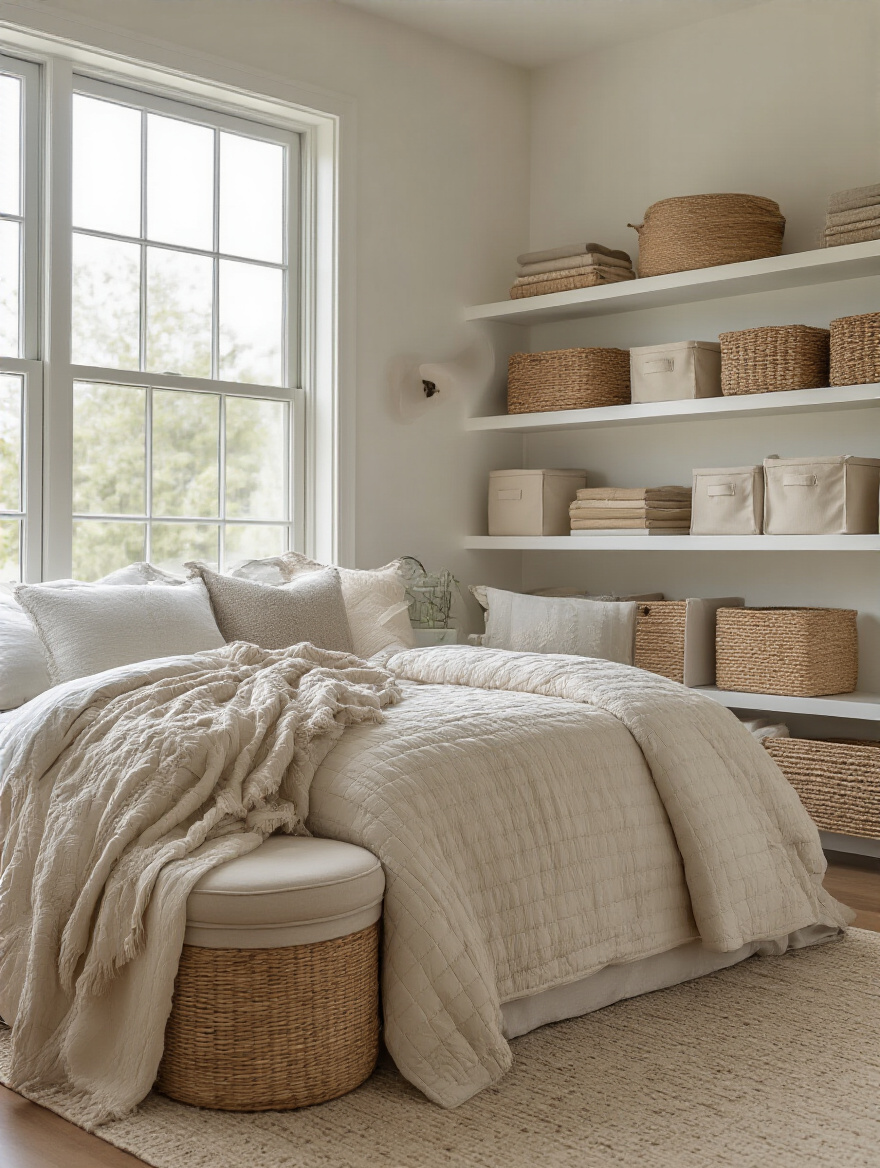
Woven baskets made of seagrass or rattan are perfect for holding extra blankets or magazines. Fabric bins can tuck neatly onto a bookshelf to hide smaller items. An upholstered storage ottoman at the foot of the bed is a brilliant multi-tasker, providing seating, storage, and another soft surface. These solutions don’t just hide your stuff; they become part of the decor, reducing sharp edges and contributing to the overall softness of the room.
Elevating Sensory Experience (Part 1)
With the room’s foundation and core comforts established, it’s time to delight the senses. These are the finishing touches that engage sight, touch, and even smell, transforming your bedroom from merely comfortable to truly restorative.
13. Add Decorative Pillows for Plushness and Visual Interest
Think of decorative pillows as the art and jewelry of the bed. They are the final layer that pulls the entire color palette and textural scheme together. The key is a thoughtful mix, not a chaotic jumble. A good formula is to start with two large “Euro” shams (the big square ones) against your headboard, then your sleeping pillows, and finally, one to three smaller accent pillows in front.
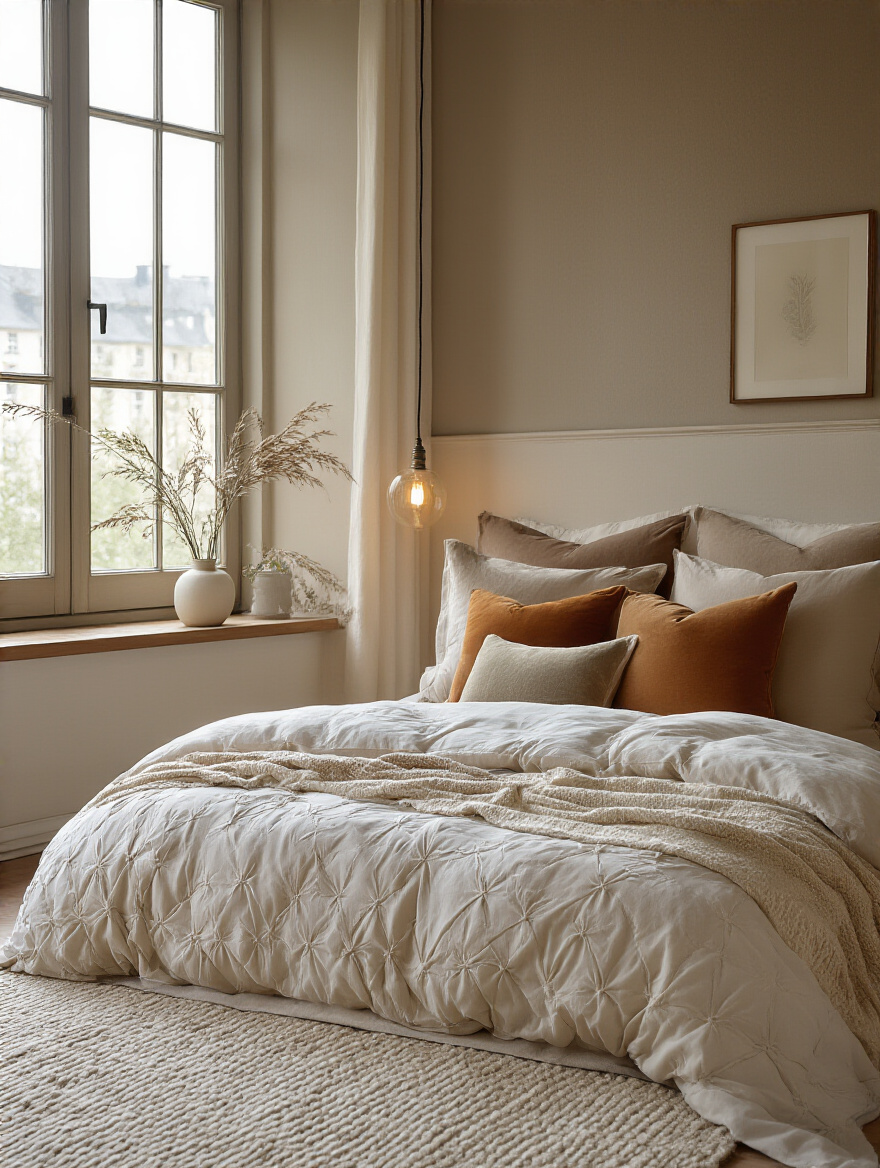
This is your chance to play with texture and pattern. If your bedding is solid, introduce a pillow with a subtle pattern. Mix materials: a smooth silk pillow next to a fuzzy boucle one, or a crisp linen next to a soft velvet. This adds depth and sophistication. My one pro-tip: always buy pillow inserts that are one size larger than your covers. A 20×20-inch cover needs a 22×22-inch insert to look full, plush, and luxurious, not sad and limp.
14. Hang Art or Mirrors that Reflect Personal Style and Light
Bare walls can feel lonely and impersonal. Art is what infuses a room with your personality. For a bedroom, choose pieces that evoke calm and serenity—abstract paintings with soft colors, quiet landscape photography, or simple botanical prints. It doesn’t need to be expensive; it just needs to speak to you.
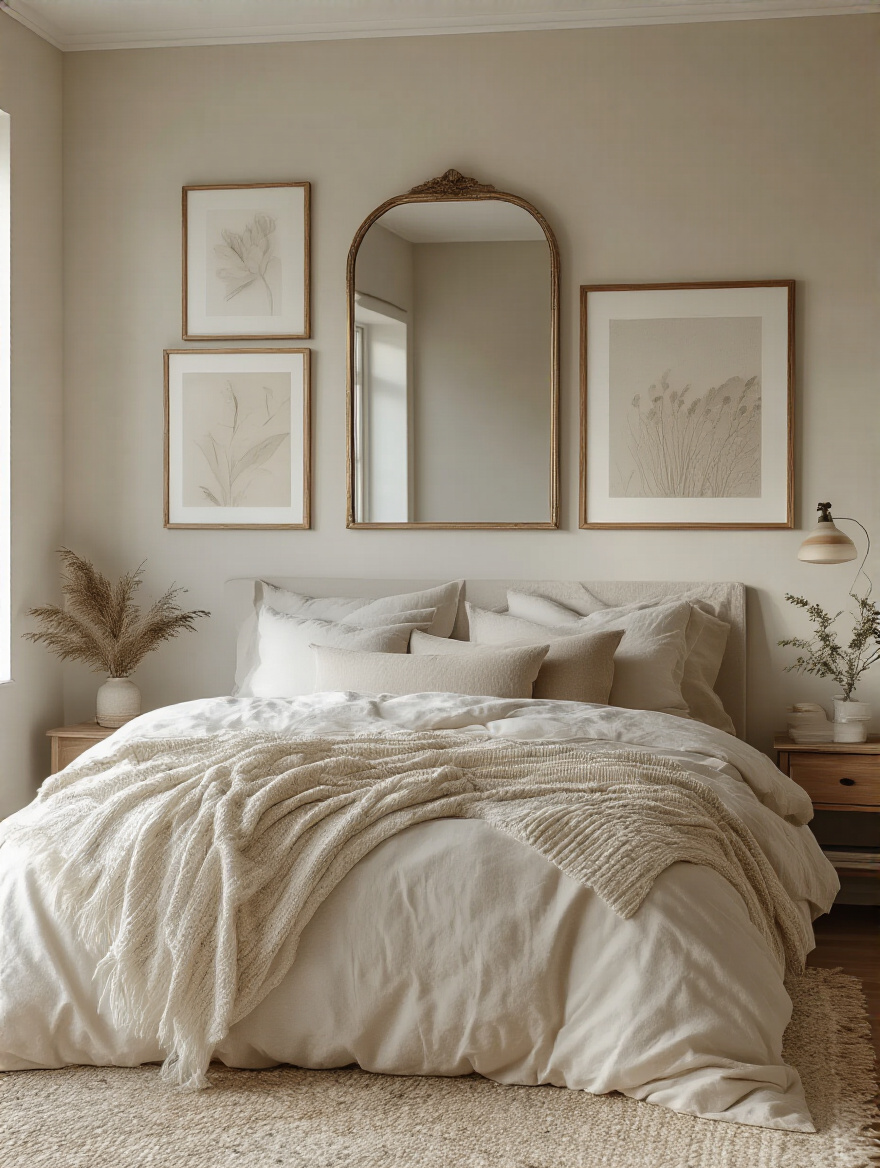
Mirrors are another powerful tool in a historic home. They were originally used to amplify precious candlelight, and they serve the same function today with our modern lamps. Placing a large mirror opposite a window will dramatically increase the natural light in the room, making it feel brighter and larger. Choose a frame with character—a vintage gilded frame or one made of reclaimed wood—to add another layer of history and texture.
15. Place Aromatic Elements for a Calming Scent Profile
Scent is the most overlooked but one of the most powerful elements in creating a cozy atmosphere. Our sense of smell is directly linked to memory and emotion. A gentle, calming scent can become a subconscious signal to your brain that it’s time to relax and unwind. This isn’t about overpowering plug-in air fresheners, which are often full of harsh chemicals.
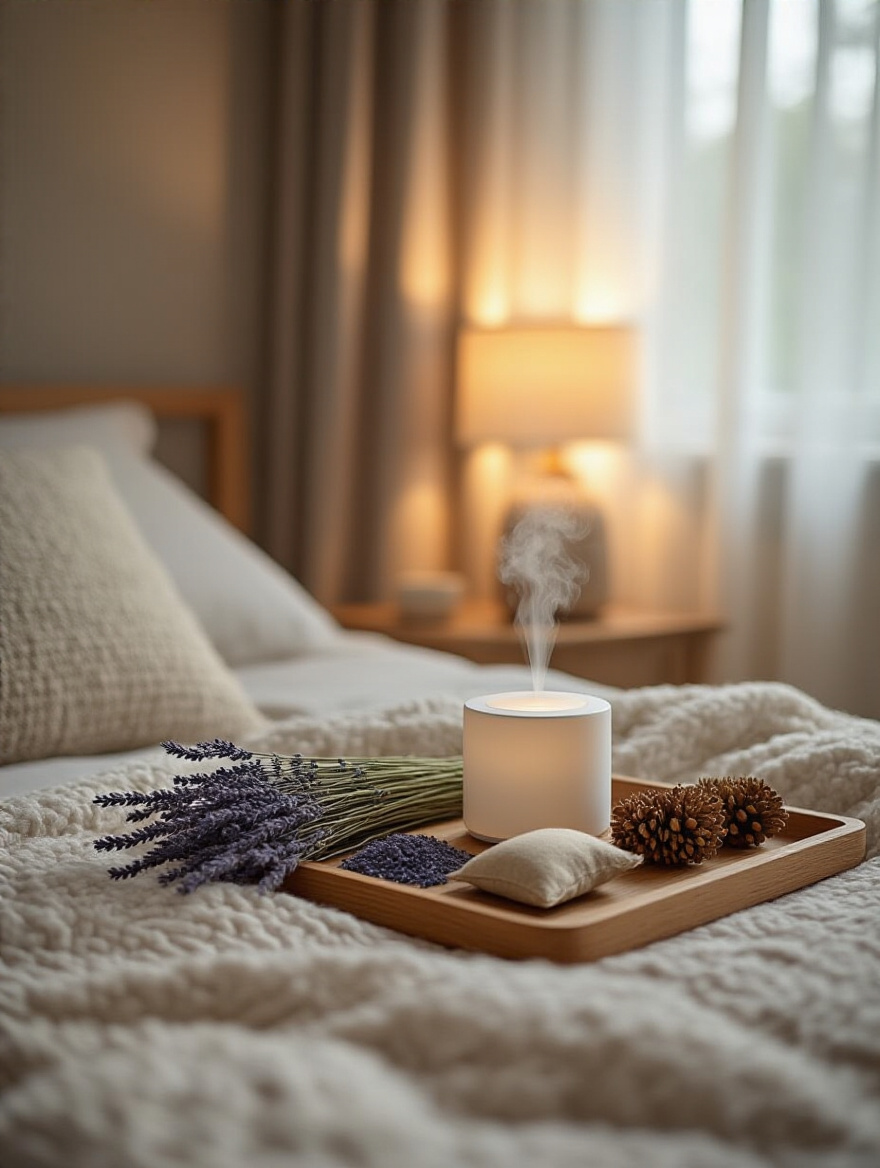
Instead, opt for natural, subtle aromas. An essential oil diffuser with lavender or cedarwood oil can fill the room with a gentle, therapeutic fragrance. Scented candles made from natural soy or beeswax provide both scent and the soft flicker of a real flame. Even a simple sachet of dried lavender tucked into your pillowcase or a vase of fresh eucalyptus on a dresser can make a world of difference. The key is subtlety; the scent should be something you discover, not something that announces itself.
16. Arrange Indoor Plants to Enhance Air Quality and Vitality
Every room needs a bit of life, and nothing does that better than a few well-placed indoor plants. They literally breathe life into a space by purifying the air, and their organic forms soften the hard lines and angles of furniture and walls. The touch of green adds vitality and a connection to the outdoors, which is inherently calming.
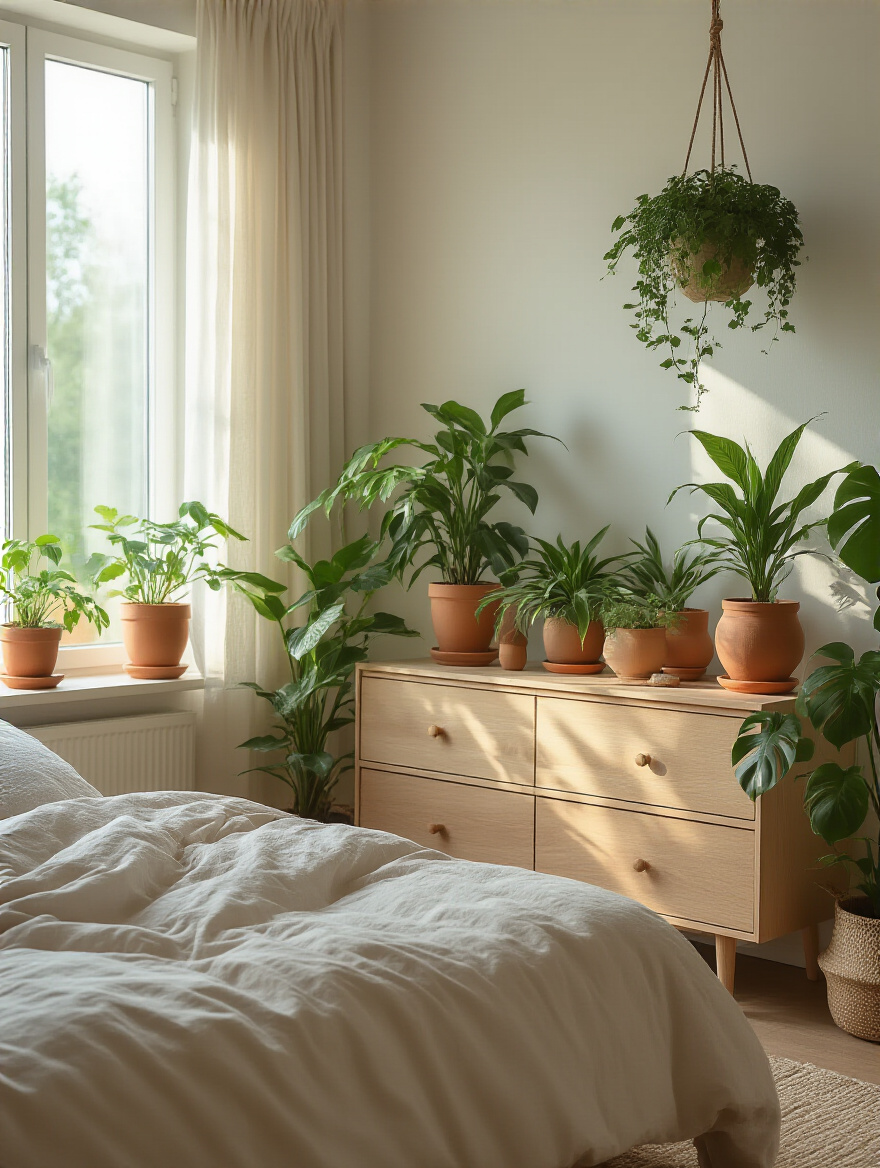
You don’t need to turn your bedroom into a jungle. One or two simple, low-maintenance plants are enough. Snake plants are practically indestructible and are one of the few plants that release oxygen at night. Pothos plants have beautiful trailing vines that look wonderful cascading down a bookshelf. Choose pots made of natural materials like terracotta or ceramic to complement the room’s other textures.
Elevating Sensory Experience (Part 2)
We continue our journey into the senses by focusing on creating experiences within the room. This is about designing dedicated zones for unplugged moments and using light in a way that feels almost magical, transforming the space into an escape from the modern world.
17. Create a Dedicated Reading Nook with a Cozy Chair and Lamp
We’ve touched on this with furniture placement, but it bears repeating: carving out a dedicated space for reading is one of the single most effective ways to make a bedroom cozier. It’s an explicit invitation to slow down, unplug, and escape into a good book. This signals that your bedroom is a multi-layered sanctuary, not just a room for sleeping.
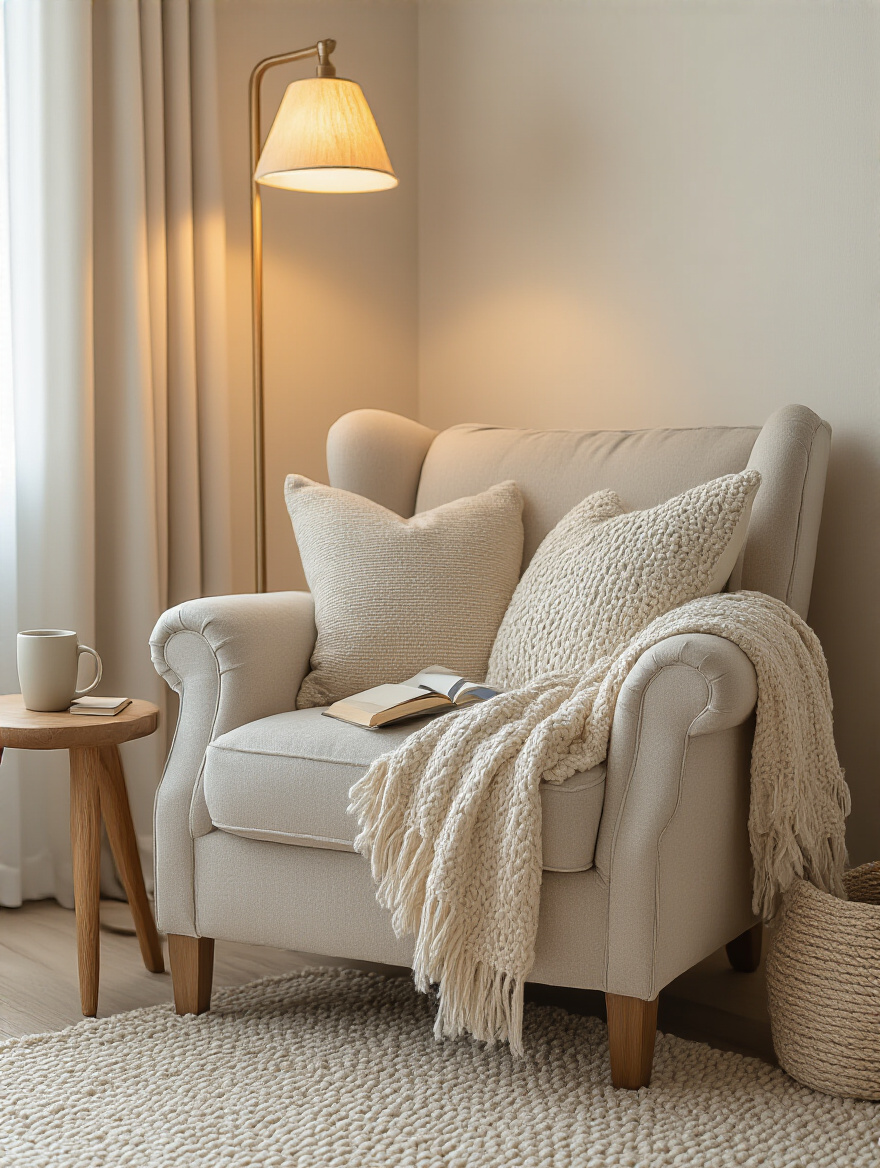
The perfect nook consists of three things: a ridiculously comfortable chair, a soft throw blanket, and a great reading lamp. Position it in a quiet corner, perhaps by a window to take advantage of natural light. This little zone becomes a powerful ritualistic space. When you sit there, you are consciously choosing to leave the stresses of the day behind.
18. Drape Fairy Lights or String Lights for a Magical Glow
Now, this can go wrong very quickly and look like a college dorm room, so listen carefully. We are not talking about blinking, multicolored lights. The key is to use warm-white, delicate fairy lights with a fine copper or silver wire. These are almost invisible during the day but provide a magical, ethereal glow at night.
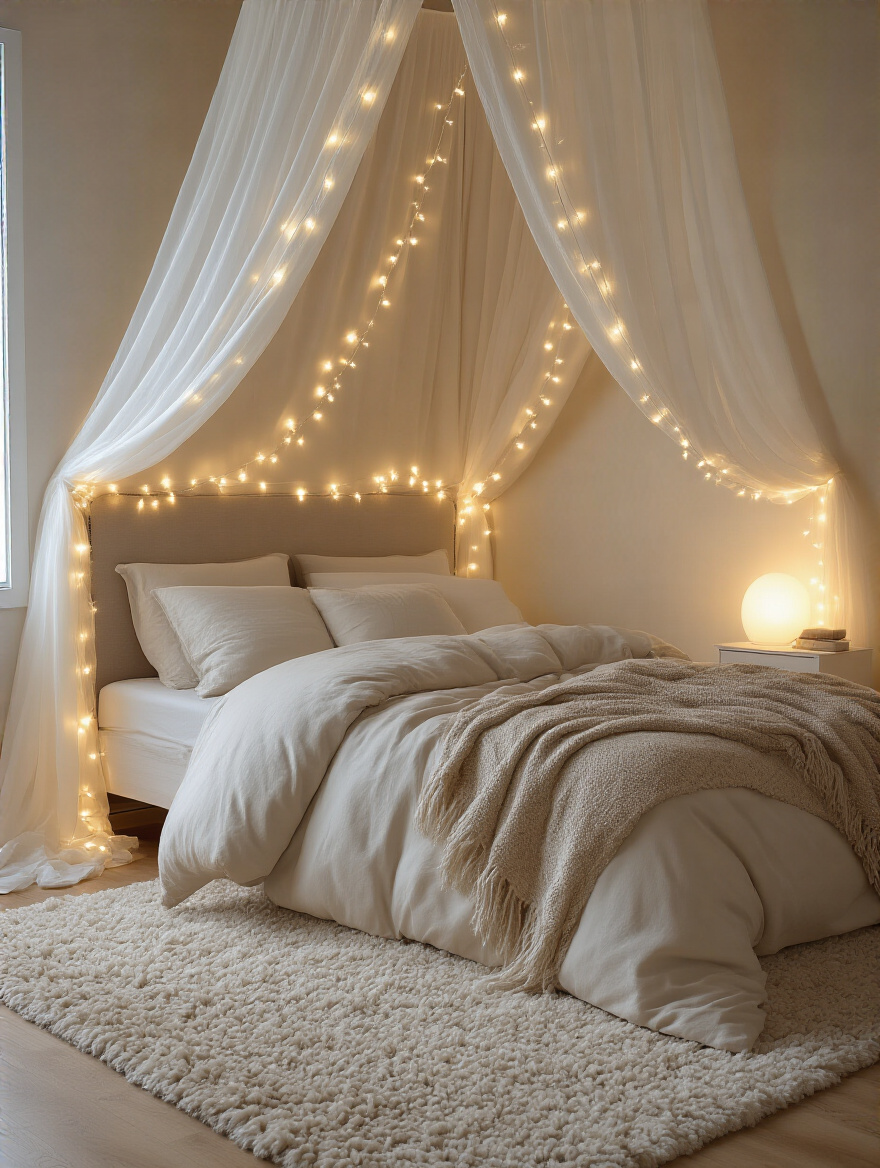
Drape them artfully around a headboard, frame a mirror, or tuck them behind a sheer curtain. They create a soft, twinkling effect that is instantly romantic and incredibly cozy. Because they are a very low level of light, they’re perfect for the last hour before sleep, creating just enough glow to navigate the room without turning on a brighter, more stimulating lamp. Used sparingly and elegantly, they are pure magic.
Sustaining the Serene Sanctuary
You’ve done the work to create a beautiful, cozy space. But a sanctuary requires upkeep. The final, and perhaps most important, part of the process is maintaining that feeling of tranquility day after day. This is about habits and environmental controls that ensure your bedroom remains a true retreat.
19. Maintain a Clutter-Free Environment for Mental Calm
I’ve said it before, but it is the most critical rule: clutter is the enemy of calm. A serene sanctuary cannot coexist with piles of laundry, stacks of paperwork, or a floor littered with odds and ends. Your brain subconsciously registers every item you see, and a cluttered space leads to a cluttered mind.
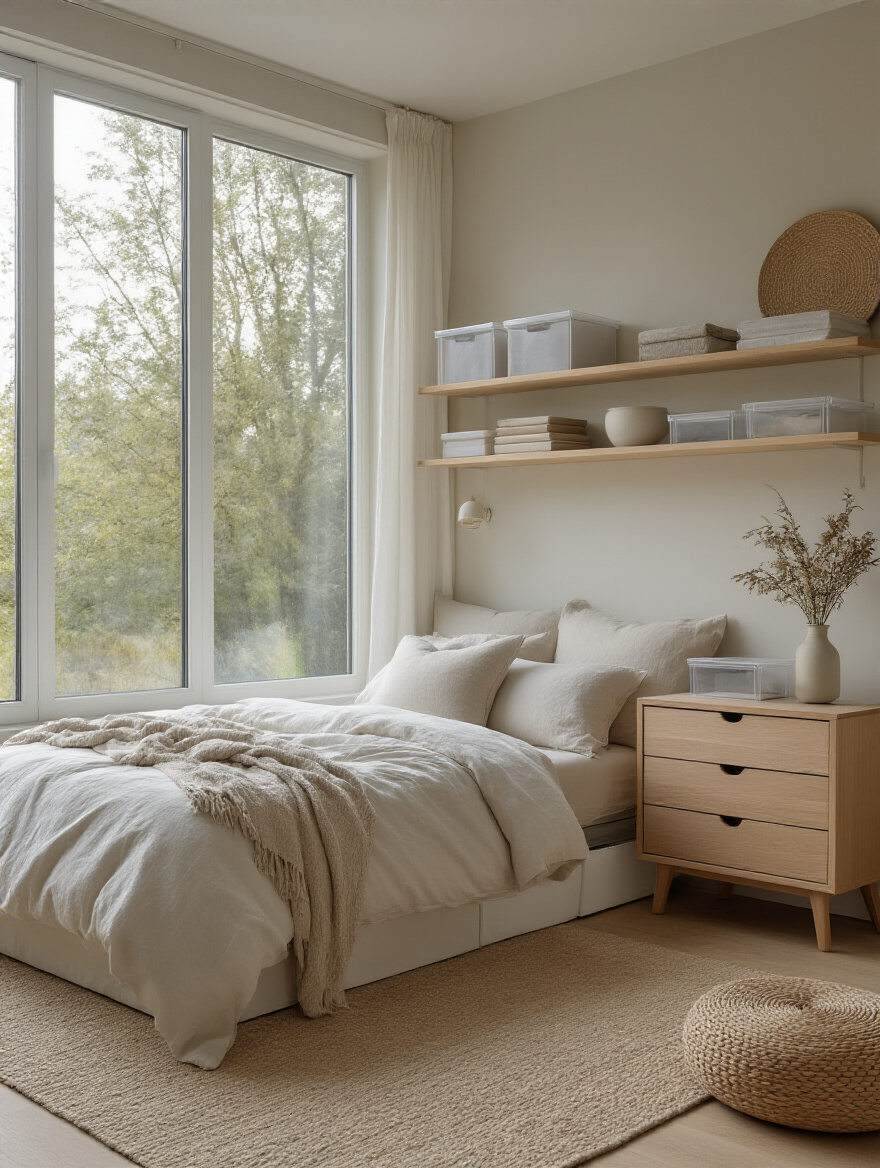
Make tidying a non-negotiable daily ritual. The “one-touch rule” is a game-changer: when you pick something up, put it away where it belongs immediately. Don’t put it down on the dresser to deal with later. Have a designated basket for things that need to leave the room. Spend just five minutes before you get into bed putting things back in their proper homes. This small habit pays huge dividends in mental peace and ensures your room is always ready to welcome you into a state of rest.
20. Optimize Room Temperature for Ultimate Sleep Comfort
You can have the coziest room in the world, but if you’re sweating or shivering all night, it doesn’t matter. Temperature is a huge factor in sleep quality. Most sleep experts agree that the ideal temperature for sleeping is surprisingly cool, typically between 60 and 67 degrees Fahrenheit (15-19°C).
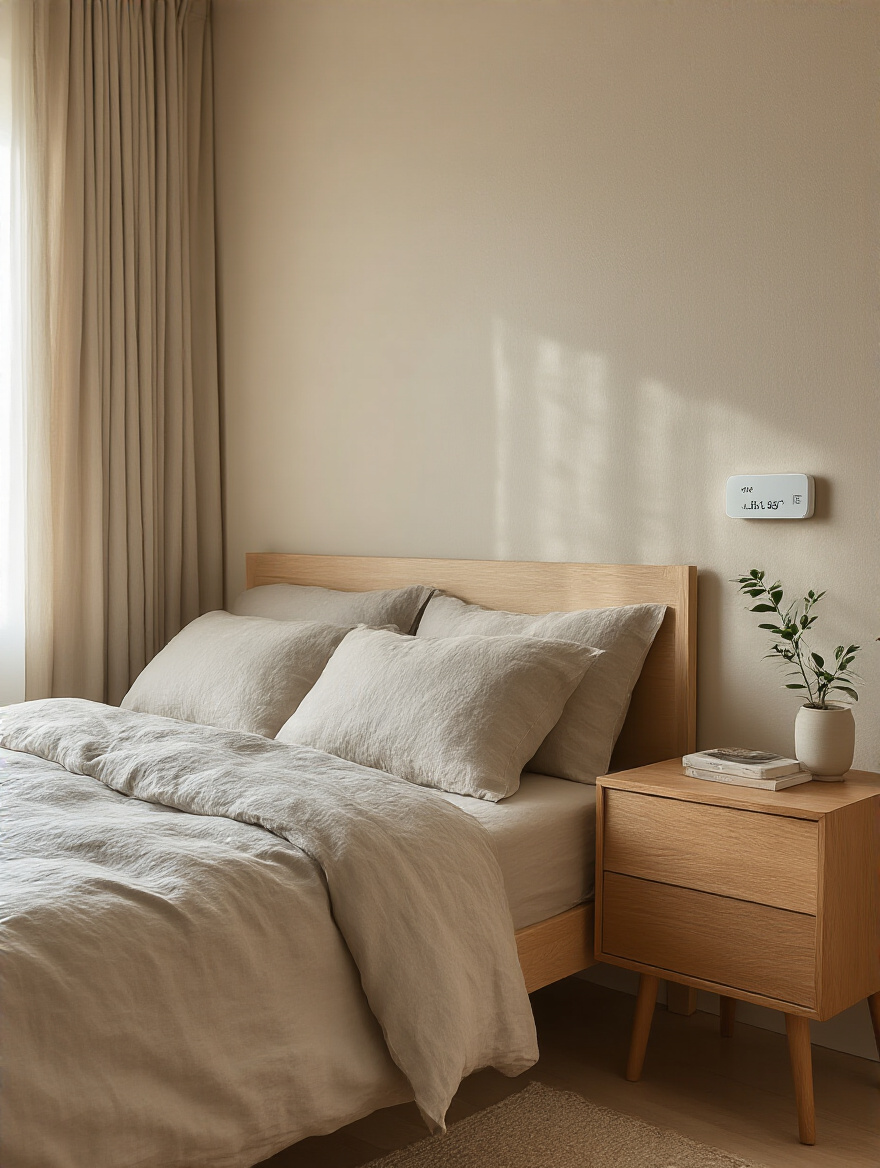
Your body temperature naturally drops as you fall asleep, and a cool room helps facilitate that process. Instead of cranking the heat, it’s far better to have a cool room and layer up with warm, breathable bedding like wool or down. This gives you the flexibility to shed a layer if you get too warm. Using a programmable or smart thermostat to automatically cool the room an hour before bed is a fantastic way to ensure the environment is perfect for sleep every single night.
21. Embrace Sound Dampening with Textiles and Decor
We often think of cozy as a visual and tactile quality, but it’s an auditory one, too. A quiet room feels safer and more cocoon-like. Historic homes can be creaky, and outside noise can be jarring. This is where all those soft textiles we’ve been adding come to the rescue again, working as a team to absorb sound.
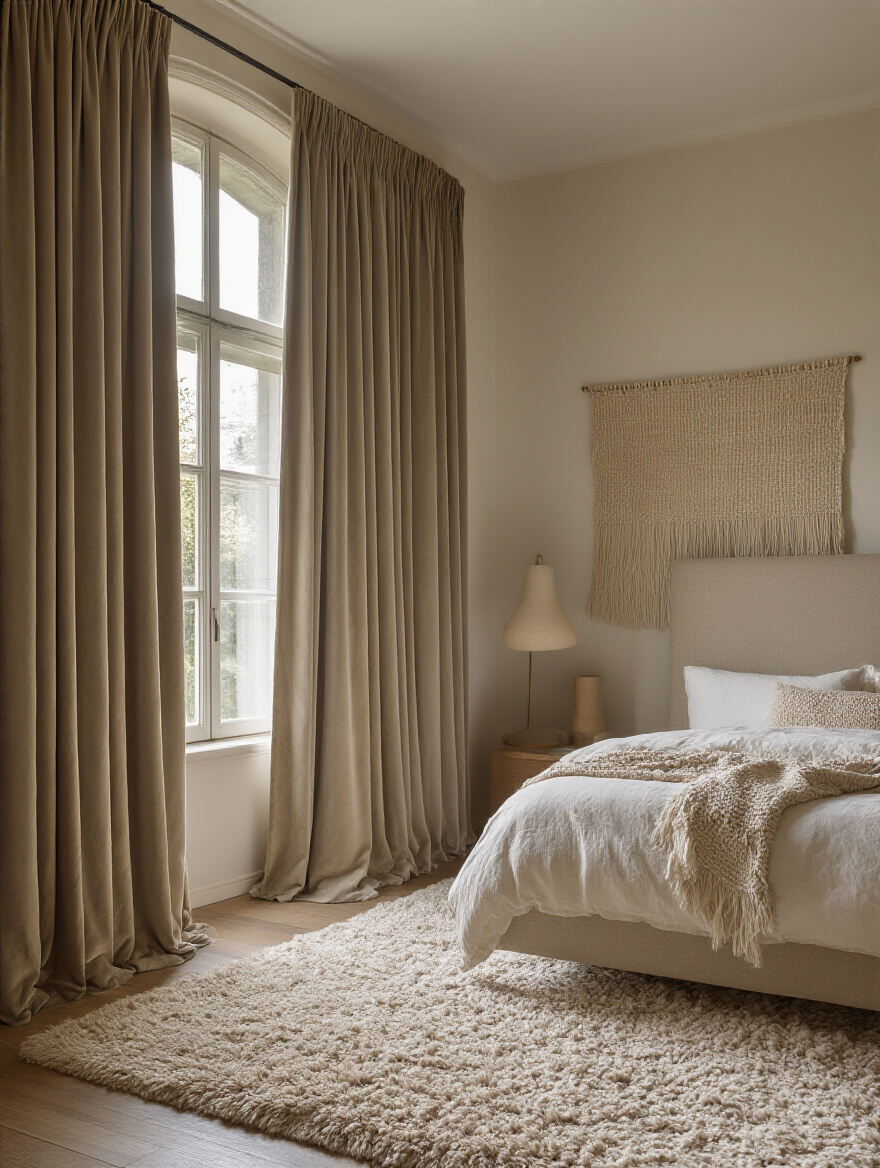
Your heavy curtains, upholstered headboard, thick area rug, and even the books on your bookshelf all act as sound dampeners. They stop sound waves from bouncing around on hard surfaces, reducing echo and muffling outside noise. If you’re particularly sensitive to sound, you can even hang a decorative textile, like a beautiful quilt or a woven tapestry, on the wall behind your bed for an extra layer of acoustic (and visual) warmth.
22. Introduce Smart Lighting Controls for Seamless Ambiance
This is the one piece of modern technology that I believe truly enhances the character of a historic home. Smart lighting allows you to perfect that layered, warm lighting scheme with incredible ease. With smart bulbs or switches, you can control every light from your phone or with your voice, dimming them to the exact percentage you want.
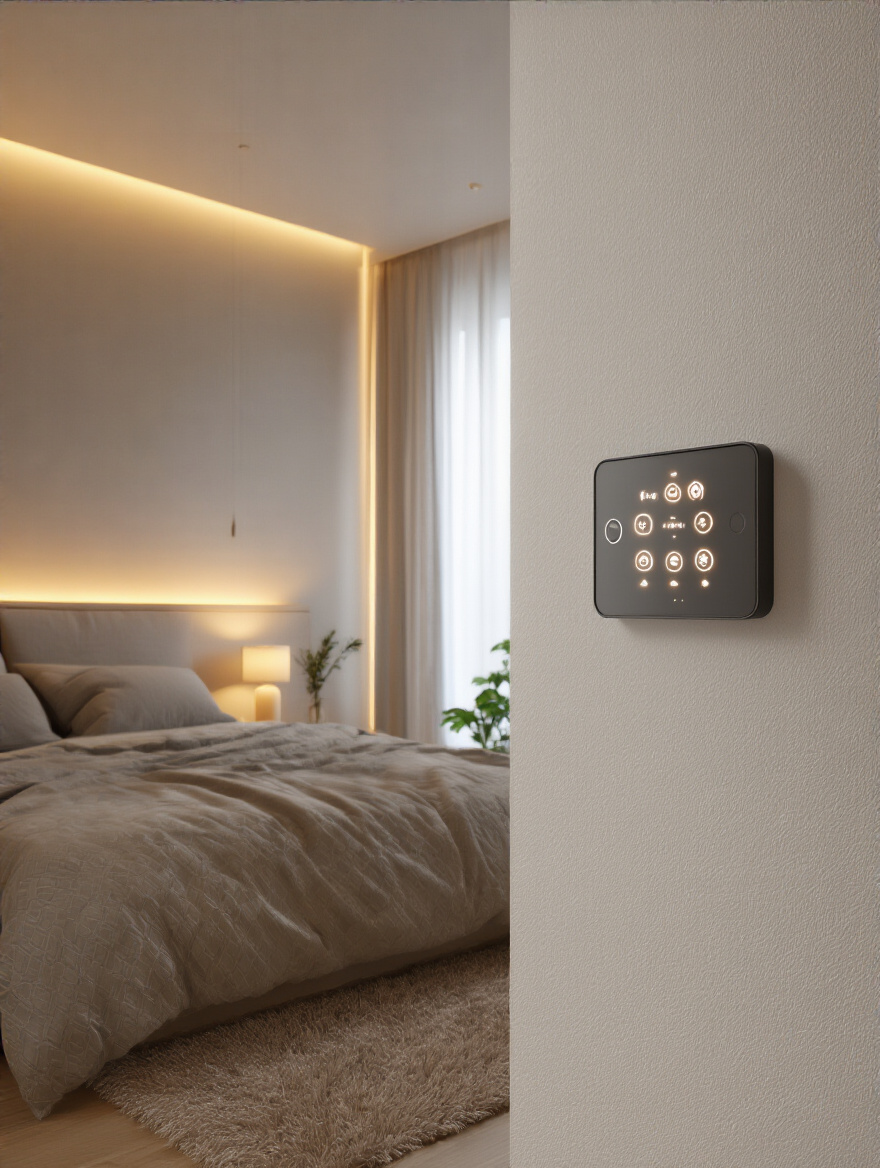
You can program “scenes” for different moods. A “Reading” scene might turn on your bedside lamp to 80% while dimming the overhead light to 20%. A “Goodnight” scene could turn everything off except for one very dim lamp that fades out over five minutes. It’s about using modern convenience not to create a futuristic, sterile environment, but to perfectly achieve a timeless, old-world ambiance that would have been impossible to manage before. It’s the ultimate tool for controlling the mood of your sanctuary.
Conclusion
Creating a truly cozy bedroom in any home, especially one with history, isn’t about following a formula or buying a checklist of items. It’s about building layers—of light, of texture, of personal meaning. We’ve talked about everything from the architectural bones of layout and color to the sensory details of scent and sound. Each element works in harmony with the others to create an environment that does more than just look nice; it actively supports your well-being.
Your bedroom is the most personal space in your home. It should be the one place where the demands of the world fall away, leaving you in a state of pure comfort and peace. So take these ideas not as rigid rules, but as inspiration. Start with one thing. Maybe it’s a new pair of linen sheets, a dimmer switch for your main light, or just five minutes of decluttering each night. Every intentional step you take is an investment in your own rest and restoration. You deserve a sanctuary, a true retreat. Now you know how to build it.
